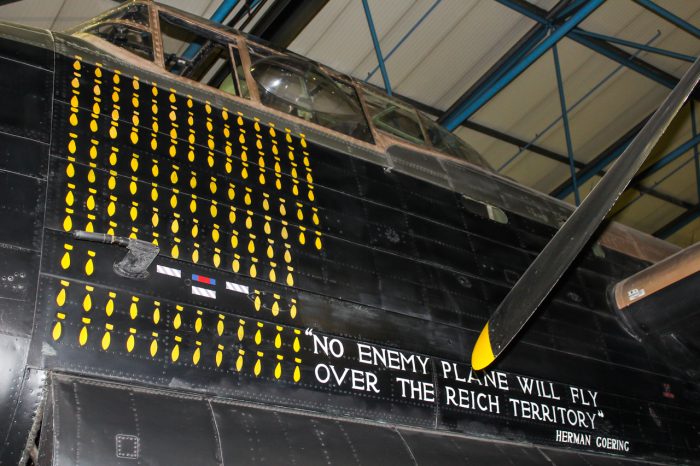Chelsea FC Adopts Lancaster at RAF Museum

The RAF Museum began an Adopt an Artifect program in July. The program allows everyone an opportunity to adopt one of 50 iconic items in the museum’s collection. Each has been chosen for the story it tells about the RAF.
Chelsea FC has taken this opportunity to continue its “Hidden Heroes” work with the museum by adopting a Lancaster bomber – the most successful of the British bombers during the war.

Adoptees receive a digital adoption certificate and photo, exclusive updates, and the option to include a dedicated message with the name of the adoptee beside the object on the museum’s new digital collections system.
Chelsea FC made the adoption in honor of the Jewish personnel that served in the RAF during the war. Many of them served on the crews of the Lancasters under Bomber Command. This is furthering the football club’s antisemitism campaign.
The funds received by the museum from the adoption of these artifacts will allow the museum to continue sharing the story of the RAF and to continue engaging, inspiring and encouraging learning today and in the future.

Bruce Buck is the chairman of the Chelsea Football Club. He said that the adoption extends the partnership began last year with the Hidden Heroes educational initiative.
Hidden Heroes strives to tell the stories of Jewish RAF personnel in the war. He said that a donation from club owner Roman Abramovich made the adoption possible.
Buck went on to say that the club’s two-year-old antisemitism program, “Say No To Antisemitism,” has convinced the club that education is key to making a difference. The club intends to continue to join with partners to tell the story about Jewish contributions to the WWII war effort.
In recognition of their contribution, a plaque will be erected by the Lancaster exhibit. The plaque will honor the contributions of Jews to WWII and to Bomber Command. Later this year, there will be an event to celebrate the adoption.
RAF Museum CEO Maggie Appleton said that the museum was “delighted” by the Chelsea adoption of the Lancaster. She said that the Lancaster was the primary bomber used by the RAF at the end of the war and that the adoption honors those who chose to serve in the Lancasters despite the high rate of casualties they sustained.

The Adopt an Artifact program has been popular since its inception in July. Playing Cards with Hidden Maps, Amy Johnson Fabric Doll and Twinkletoes the Cat have been some of the most popular items adopted.
Messages from the adoptees can be seen online dedicated to loved ones or expressing appreciation for the work of the RAF.
The Lancaster, also known as the Avro Lancaster, was first flown in 1939 and entered production the nest year. Originally manufactured by Manchester, there were problems with the engine which prevented them from producing them in any great number.
Avro stepped in with a redesign using Rolls-Royce Merlin engines to replace the problematice Rolls-Royce Vulture engines.
Another Article From Us: Got a spare $12 MILLION – Then This P-82 Twin Mustang is Yours
The new Lancaster entered combat in April of 1942. They were pressed into use for the nighttime bombing raids over Germany. Lancasters were used in the famous “Dambuster” raid that destroyed the M ö hne, Sorpe, and Eder hydroelectric dams. They were also part of the sinking of the German battleship Tirpitz in Norway.
